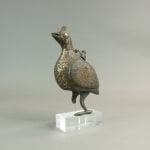Seljuk Bronze Oil Lamp in the Shape of a Bird, 11th to 12th century CE
Bronze
height 17.5 cm
height 6 7/8 in
dimensions given without mounting
height 6 7/8 in
dimensions given without mounting
ES.9836
Further images
-
(View a larger image of thumbnail 1
)

-
(View a larger image of thumbnail 2
)

-
(View a larger image of thumbnail 3
)

-
(View a larger image of thumbnail 4
)

-
(View a larger image of thumbnail 5
)

-
(View a larger image of thumbnail 6
)

-
(View a larger image of thumbnail 7
)

-
(View a larger image of thumbnail 8
)

-
(View a larger image of thumbnail 9
)

-
(View a larger image of thumbnail 10
)

-
(View a larger image of thumbnail 11
)

-
(View a larger image of thumbnail 12
)

The Seljuk dynasty was of a Sunni Muslim dynasty of western Turkic origins that gradually became hugely influenced by the Persian language, culture, literature, art, and/or identity and contributed to...
The Seljuk dynasty was of a Sunni Muslim dynasty of western Turkic origins that gradually became hugely influenced by the Persian language, culture, literature, art, and/or identity and contributed to the Turko-Persian tradition in the medieval West and Central Asia, from 1037 to 1194 AD. The Seljuks established both the Seljuk Empire and the Sultanate of Rum, which at their territorial heights stretched from Anatolia through Iran and were targets of the First Crusade.
Nowadays, the Seljuks are considered by scholars and historians as great patrons of Persian culture, art, literature, and language and are regarded as the ancestors of the present- day inhabitants of Azerbaijan, Turkey, and Turkmenistan.
Nowadays, the Seljuks are considered by scholars and historians as great patrons of Persian culture, art, literature, and language and are regarded as the ancestors of the present- day inhabitants of Azerbaijan, Turkey, and Turkmenistan.











